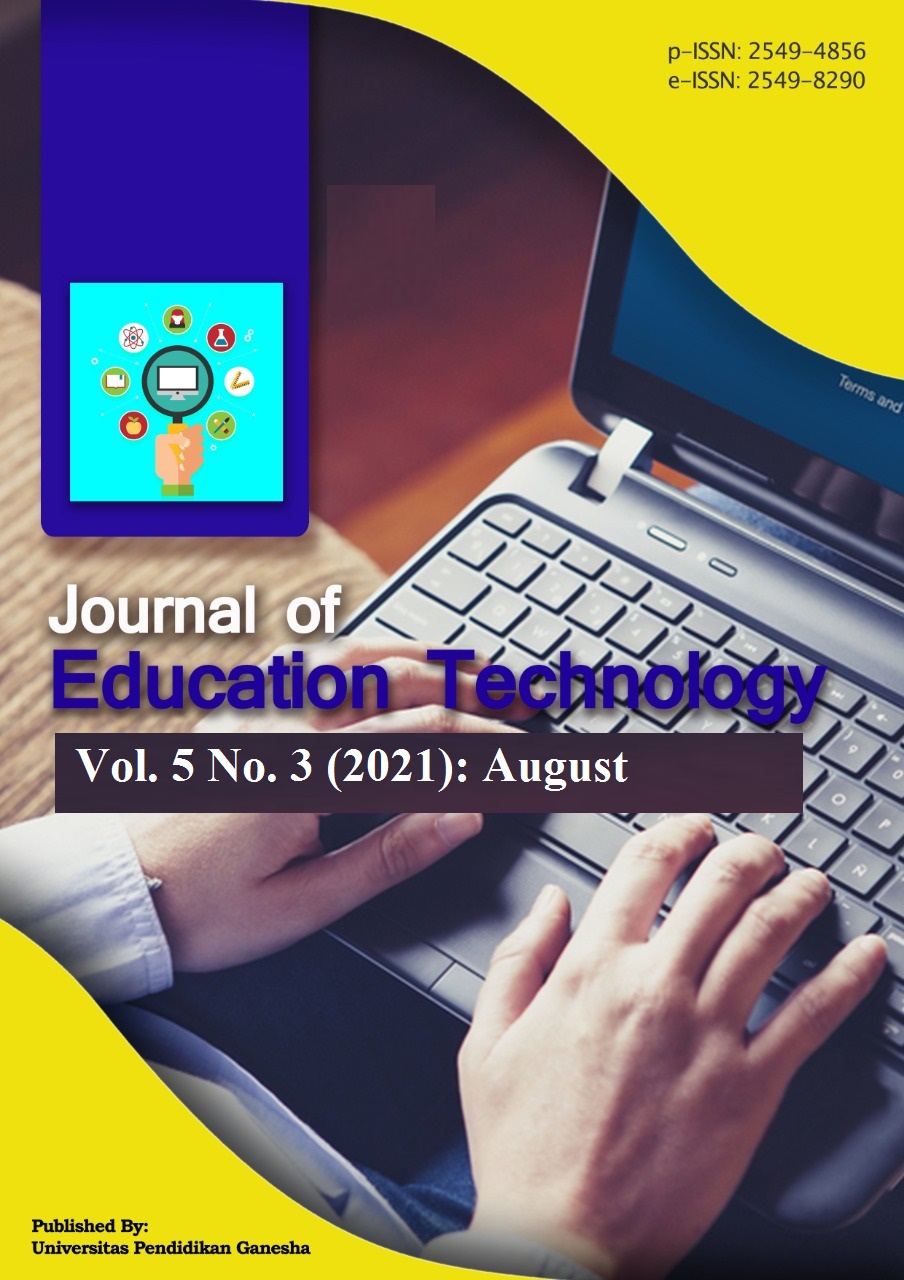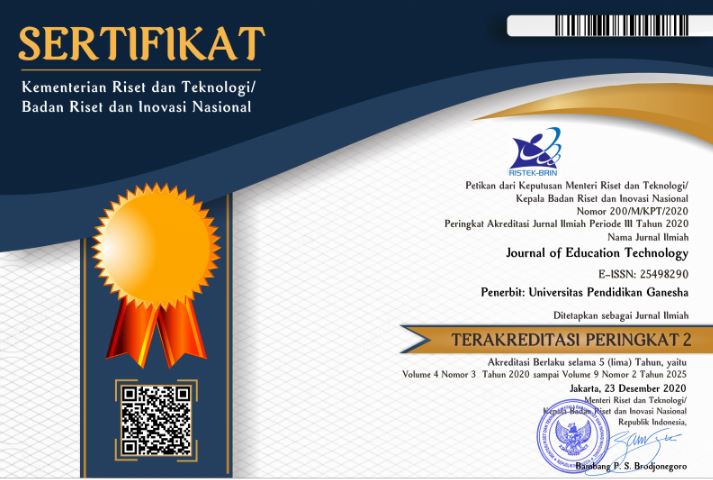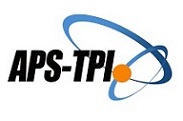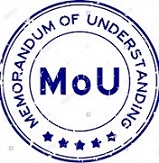E-Report: Holistic Assessment System in Elementary School
DOI:
https://doi.org/10.23887/jet.v5i3.39017Keywords:
assessment system, education unit, student report cardAbstract
A good learning is supported by not only good planning and learning processes, but it is also supported by an assessment of students’ competencies achievement. This study aims to develop a learning outcome assessment system based on educational units (students’ reports) in elementary schools. This is development research using Development and Diffusion (R-D-D) model. The data in this study were collected through interviews, observations, questionnaires, documentation studies, FGDs, and product trials. The data were analyzed using a qualitative approach. The results showed that the percentage level of achievement of the unit-based learning outcomes assessment system was 97.3% so which fell into Very Good qualification with the achievement level scale of 5 in the conversion table. Based on this, it can be concluded that the Student Report (SR) system is appropriate to be used as an education unit-based learning outcome assessment system in elementary school. This research implies that teachers can use the developed E-report as a learning outcomes assessment system based on education units in elementary schools.
References
Abosalem, Y. (2016). Assessment techniques and students’ higher-order thinking skills. International Journal of Secondary Education, 4(1), 1–11. https://doi.org/10.11648/j.ijsedu.20160401.11.
All, A., Castellar, E. N. P., & Looy, J. Van. (2021). Digital Game-Based Learning effectiveness assessment: Reflections on study design. Computers & Education, 167. https://doi.org/10.1016/j.compedu.2021.104160.
Alruwais, N., Wills, G., & Wald, M. (2018). Advantages and Challenges of Using e-Assessment. International Journal of Information and Education Technology, 8(1), 34–37. https://doi.org/10.18178/ijiet.2018.8.1.1008.
Astalini, A., Darmaji, D., Kurniawan, W., Anwar, K., & Kurniawan, D. A. (2019). Effectivenes of Using E-Module and E-Assessment. International Journal of Interactive Mobile Technologies (IJIM), 13(09), 21–39. https://doi.org/10.3991/ijim.v13i09.11016.
Bdiwi, R., de Runz, C., Faiz, S., & Cherif, A. A. (2019). Smart learning environment: Teacher’s role in assessing classroom attention. Research in Learning Technology, 27, 1–14. https://doi.org/10.25304/rlt.v27.2072.
Brookhart, S. M., Guskey, T. R., Bowers, A. J., McMillan, J. H., Smith, J. K., Smith, L. F., Stevens, M. T., & Welsh, M. E. (2016). A Century of Grading Research: Meaning and Value in the Most Common Educational Measure. Review of Educational Research, 84(4). https://doi.org/10.3102/0034654316672069.
Buchori, Rahmawati, S., & Wardani, S. (2017). The Development of A Learning Media for Visualizing the Pancasila Values Based on Information and Communication Technology. Jurnal Cakrawala Pendidikan, 36(3), 502–521. https://doi.org/10.21831/cp.v36i3.12748.
Danniels, E., Pyle, A., & DeLuca, C. (2020). The role of technology in supporting classroom assessment in play-based kindergarten. Teaching and Teacher Education, 88. https://doi.org/10.1016/j.tate.2019.102966.
Dewi, D. A. P., Wiyasa, I. K. N., & Ganing, N. N. (2014). Pengaruh Model Pembelajaran Circuit Learning Berbantuan Media Audiovisual Terhadap Hasil Belajar Ips Siswa Sd Negeri 1 Pejeng Tahun Pelajaran 2013/2014. Jurnal Mimbar PGSD Universitas Pendidikan Ganesha, 2(1). https://doi.org/10.23887/jjpgsd.v2i1.2226.
Granberg, C., Palm, T., & Palmberg, B. (2021). A case study of a formative assessment practice and the effects on students’ self-regulated learning. Studies in Educational Evaluation. https://doi.org/10.1016/j.stueduc.2020.100955.
Hanifah, N. (2019). Pengembangan instrumen penilaian Higher Order Thinking Skill ( HOTS ) di sekolah dasar. Current Research in Education, 1(1). https://ejournal.upi.edu/index.php/crecs/article/view/14286.
Hansen, G. (2020). Formative assessment as a collaborative act. Teachers` Intention and Students` Experience: Studies in Educational Evaluation, 66. https://doi.org/10.1016/j.stueduc.2020.100904.
Heo, M., & Toomey, N. (2020). Learning with multimedia: The effects of gender, type of multimedia learning resources, and spatial ability. Computers and Education, 146, 103747. https://doi.org/10.1016/j.compedu.2019.103747.
Hignasari, L. V., & Supriadi, M. (2020). Pengembangan E-Learning dengan Metode Self Assessment Untuk Meningkatkan Hasil Belajar Matematika Mahasiswa Universitas Mahendradatta. Jurnal Kependidikan, 6(2). https://doi.org/10.33394/jk.v6i2.2476.
Indah Septiani, A. nisa N. S., Septiani, I., Rejekiningsih, T., Triyanto, & Rusnaini. (2020). Development of interactive multimedia learning courseware to strengthen students’ character. European Journal of Educational Research, 9(3), 1267–1279. https://doi.org/10.12973/eu-jer.9.3.1267.
Juliantri, L., Florentinus, T. S., & Wibawanto, H. (2017). Pengembangan e-Rapor Kurikulum 2013 Berbasis Web di SMK Negeri 1 Slawi. Innovative Journal of Curriculum and Educational Technology, 6(1). https://journal.unnes.ac.id/sju/index.php/ujet/article/view/15571.
Kamaruddin, & Haryanto. (2014). Pengembangan Sistem Penilaian Hasil Belajar Mata Pelajaran Menganalisis Rangkaian Listrik Berbasis Computerized Adaptive Testing. Jurnal Pendidikan Vokasi, 4(1). https://doi.org/https://doi.org/10.21831/jpv.v4i1.2533.
Kaplan, L. R., Farooque, M., Sarewitz, D., & Tomblin, D. (2021). Designing Participatory Technology Assessments: A Reflexive Method for Advancing the Public Role in Science Policy Decision-making. Technological Forecasting and Social Change, 171. https://doi.org/10.1016/j.techfore.2021.120974.
Khan, F. M. A., & Masood, M. (2015). The Effectiveness of an Interactive Multimedia Courseware with Cooperative Mastery Approach in Enhancing Higher Order Thinking Skills in Learning Cellular Respiration. Procedia - Social and Behavioral Sciences, 176, 977–984. https://doi.org/10.1016/j.sbspro.2015.01.567.
Klapp, A. (2015). Does grading affect educational attainment? A longitudinal study. Assessment in Education: Principles, Policy and Practice, 22(3). https://doi.org/10.1080/0969594X.2014.988121.
Koswara, A. N. M. (2018). Pengaruh Kemudahaan Akses Informasi Internet Melalui Konteks Sosial Pelajar Terhadap Kecenderungan Tindakan Plagiarisme Dalam Penulisan Karya Tulis Di Kalangan Pelajar. Jurnal Masyarakat Telematika Dan Informatika, 9(1). https://doi.org/10.17933/mti.v9i1.115.
Layuk, A., Hamdani, H., & Khairina, D. M. (2014). Sistem Informasi Pengolahan Nilai Raport Berbasis Web Sekolah Sosial Olahraga (Studi Kasus: Real Madrid Foundation Samarinda). Informatika Mulawarman, 9(3). https://doi.org/dx.doi.org/10.30872/jim.v9i3.176.
Mayer, R. E. (2012). A Cognitive Theory of Multimedia Learning. Multimedia Learning, July, 41–62. https://doi.org/10.1017/cbo9781139164603.004.
McGarr, O., & Gallchóir, C. Ó. (2021). Examining supervising field instructors’ reporting and assessment of technology use by pre-service teachers on school placement. Computers & Education, 146. https://doi.org/10.1016/j.compedu.2019.103753.
Nurhayati, A. (2016). Prinsip dan tujuan penilaian tindakan kelas. Jurnal Pembelajaran, 5(1). https://doi.org/10.24252/ip.v5i1.3200.
Pangastuti, A. D., & Priantinah, D. (2019). Penerapan Sistem Informasi Raport Online. Ekuitas: Jurnal Pendidikan Ekonomi, 7(1). https://doi.org/10.23887/ekuitas.v7i1.16488.
Pangastuti, P. A. D., & Priantinah, D. (2019). Penerapan Sistem Informasi Raport Online. Ekuitas: Jurnal Pendidikan Ekonomi, 7(1). https://ejournal.undiksha.ac.id/index.php/EKU/article/view/16488/10690.
Pranatawijaya, V. H., Widiatry Priskila, R., & Putra, P. B. A. A. (2019). Pengembangan Aplikasi Kuesioner Survey Berbasis Web Menggunakan Skala Likert dan Guttman. Jurnal Sains Dan Informatika, 5(2). https://doi.org/10.34128/jsi.v5i2.185.
Rambe, K. R. N. (2018). Penerapan Strategi Index Card Match Untuk Meningkatkan Hasil Belajar Siswa Pada Mata Pelajaran Bahasa Indonesia. Jurnal Tarbiyah, 25(1), 93–124. https://doi.org/https://www.researchgate.net/deref/http%3A%2F%2Fdx.doi.org%2F10.30829%2Ftar.v25i1.237.
Saito, E., Reisch, R., & Davis-Risen, S. (2021). Utilizing a faculty-led student assessment team to evaluate international interprofessional service learning opportunities. Currents in Pharmacy Teaching and Learning, 13(9). https://doi.org/10.1016/j.cptl.2021.06.037.
Schildkamp, K., Kleij, van der, Heitink, Kippers, W. B., & Veldkamp, B. P. (2020). Formative assessment: A systematic review of critical teacher prerequisites for classroom practice. International Journal of Educational Research. https://doi.org/10.1016/j.ijer.2020.101602.
Segers, M., Martens, R., & Bossche, P. Van den. (2018). Understanding how a case-based assessment instrument influences student teachers’ learning approaches. Teaching and Teacher Education, 24(7). https://doi.org/10.1016/j.tate.2008.02.022.
Suryani, L. (2016). Pengembangan Instrumen Penilaian Sikap Ilmiahpada Pembelajaran Dengan Model Latihan Penelitian Di Sekolah Dasar. Jurnal Pedadidaktika, 3(2). https://ejournal.upi.edu/index.php/pedadidaktika/article/view/5152/0.
Szanto, B. (2020). Reading and Writing Comprehension in the Mother Tongue in the Romanian National Assessment – Objectives, Tests, Results. Technium Social Science Journal, 9. https://doi.org/10.47577/tssj.v9i1.933.
Tan, J., Yang, Z., Cheng, Y., Ye, J., Wang, B., & Dai, Q. (2021). SRAGL-AWCL: A two-step multi-view clustering via sparse representation and adaptive weighted cooperative learning. Pattern Recognition, 117. https://doi.org/10.1016/j.patcog.2021.107987.
Tempelaar, D. (2019). Assessment & Evaluation in Higher Education Supporting the less-adaptive student: The role of learning analytics, formative assessment and blended learning. Assessment and Evaluation in Higher Education, 45(4). https://doi.org/10.1080/02602938.2019.1677855.
Umami, M. (2018). Penilaian Autentik Pembelajaran Pendidikan Agama Islam dan Budi Pekerti dalam Kurikulum 2013. Jurnal Kependidikan, 6(2). https://doi.org/10.24090/jk.v6i2.2259.
Wahyuningsih, R., Wahyuni, S., & Lesmono, A. D. (2016). Pengembangan Instrumen Self Assessment Berbasis Web Untuk Menilai Sikap Ilmiah pada Pembelajaran Fisika di SMA. Jurnal Pembelajaran Fisika, 4(4), 338–343. https://jurnal.unej.ac.id/index.php/JPF/article/view/3087.
Wegmann, K. M., & Smith, B. (2019). Examining racial/ethnic disparities in school discipline in the context of student-reported behavior infractions. Children and Youth Services Review, 103. https://doi.org/10.1016/j.childyouth.2019.05.027.
Widiana, I. W. (2016). Pengembangan Assesmen Proyek dalam Pembelajaran IPA di Sekolah Dasar. Jurnal Pendidikan Indonesia, 5(2). https://doi.org/10.23887/jpi-undiksha.v5i2.8154.
Wijasty, F. A., Utami, L. D., Yunandar, R. T., & Priyono, P. (2019). Aplikasi Sistem Informasi Raport Online (Studi Kasus: Mi Darul Muta’allimien Leuwiliang Bogor). Jurnal Ilmu Pengetahuan Dan Teknologi Komputer, 5(1). https://doi.org/10.33480/jitk.v5i1.685.
Wright, McDowell, Leese, & McHardy, K. C. (2010). A scoping exercise of work-based learning and assessment in multidisciplinary health care in Scotland. Journal of Practice Teaching & Learning, 10(2). https://doi.org/10.1921/ 174661110X592737.
Xiao, Y., & Yang, M. (2019). Formative assessment and self-regulated learning: How formative assessment supports students’ self-regulation in English language learning. System, 81. https://doi.org/10.1016/j.system.2019.01.004.
Zhang, J., Liao, G., & Li, N. (2020). Combining active learning and local patch alignment for data-driven facial animation with fine-grained local detail. Neurocomputing, 39. https://doi.org/https://doi.org/10.1016/j.neucom.2019.05.102.
Zulfiani, Suwarna, I. P., & Sumantri, M. F. (2020). Science adaptive assessment tool: Kolb’s learning style profile and student’s higher order thinking skill level. Jurnal Pendidikan IPA Indonesia, 9(2), 194–207. https://doi.org/10.15294/jpii.v9i2.23840.
Downloads
Published
How to Cite
Issue
Section
License
Authors who publish with the Journal of Education Technology agree to the following terms:
- Authors retain copyright and grant the journal the right of first publication with the work simultaneously licensed under a Creative Commons Attribution License (CC BY-SA 4.0) that allows others to share the work with an acknowledgment of the work's authorship and initial publication in this journal.
- Authors are able to enter into separate, additional contractual arrangements for the non-exclusive distribution of the journal's published version of the work (e.g., post it to an institutional repository or publish it in a book), with an acknowledgment of its initial publication in this journal.
- Authors are permitted and encouraged to post their work online (e.g., in institutional repositories or on their website) prior to and during the submission process, as it can lead to productive exchanges, as well as earlier and greater citation of published work. (See The Effect of Open Access)
















